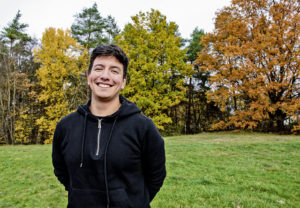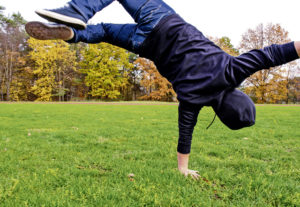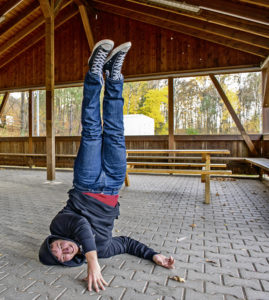
For many people, meditation involves a serene environment and minimal activity. However, one Airman achieves relaxation through a more physical means, which combines music and dance into an elaborate art.
“For me, it’s more of just being a meditation thing,” said Airman 1st Class Manuel Zamora. “It’s a health thing for me. It’s a way for me to give my brain a break, organize itself and be free from everything.”
Breaking, or breakdancing, is a combination of dance and music. For the 86th Airlift Wing Public Affairs specialist, breakdancing is a way of interpreting music through dance technique. This process of translating the unseen into something more tangible is unique to each break dancer.
“Breaking is complete freedom of expression with your body,” Zamora said. “It’s music made visible with your body. You can do whatever you want with the way you hear and interpret the music.”
As Zamora interprets music through physical movement, it also helps shape his identity as an American citizen through a sense of community found with other break dancers.

“I’m considered a first-generation American,” Zamora said. “This was my way of feeling American. Everybody here is just like me, or just as different as me. And we’re all together doing this one thing. It was a way of connecting.”
Zamora began breakdancing at age 14 in Fresno, California. He discovered breakdancing through school events that featured local talent. The community found with other dancers made it clear to Zamora that breakdancing exposed more common ground within his circle of artists.
“Because we obviously like [dancing], there has to be other things we have in common,” Zamora said.
While some of his exposure to breakdancing is in a group setting, it also seeps into his daily routine. Zamora describes the frequency of his dance sessions as something born out of sporadic inspiration while going about his day.
“I’m making something to eat and I’m playing music,” Zamora said. “I may like the song. Next thing you know, it’s been two hours and I’ve been dancing.”
Continually striving to learn his craft means coupling long-term commitment with the development of a unique style.
“I don’t want someone to be exactly like me,” Zamora said. “And I don’t want to be exactly like somebody else.”
Despite his sense of individuality in dance, Zamora recognizes the importance of learning foundational movements. Zamora instructed young children on how to breakdance in 2011 as a sports coordinator.

“It was my favorite job,” Zamora said, reflecting on his time at the Boys and Girls Club of America.
The fundamental moves he passed on to these children provided them with a basic understanding needed to continue growing in the art.
“You give them just a few tools,” Zamora said. “And then after that, they’re building a house with it. That’s the beauty of the art. The beauty of the dance. It helps with confidence.”
Zamora lives this conviction through the self-assurance he experiences first-hand as he performs with confidence.
“I never feel like I lack any confidence when it comes to dancing,” Zamora said. “That’s my world. That’s where I belong.”
The self-confidence he describes, combined with a sense of relaxed awareness, lays the groundwork for continuous improvement and maximized potential.
“I think the greatest thing about dancing is that you can be silly; and that would probably make it even better,” Zamora said. “The people who don’t take themselves too seriously when they’re dancing are probably the best ones.”
Having the freedom of expression through dance allows Zamora to thrive in a more structured community within the Air Force. This balance of energy allows him to continue serving to the best of his ability.
“In the Air Force, there’s always something coming at you and you have to be prepared for it,” Zamora said. “I’d say [breakdancing] allows me to get my energy back in focus. Then, I go on the attack and give whatever I need to get the job done.”


